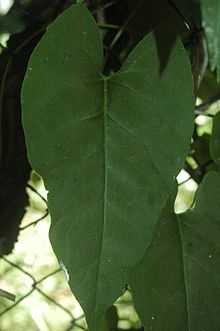Fallopia multiflora
| Fallopia multiflora | |
|---|---|
 | |
| Scientific classification | |
| Kingdom: | Plantae |
| (unranked): | Angiosperms |
| (unranked): | Eudicots |
| (unranked): | Core eudicots |
| Order: | Caryophyllales |
| Family: | Polygonaceae |
| Genus: | Fallopia |
| Species: | F. multiflora |
| Binomial name | |
| Fallopia multiflora (Thunb.) Haraldson | |
| Synonyms | |
Fallopia multiflora (Chinese Knotweed; Chinese: 何首乌; hé shǒu wū) is a species of Fallopia native to central and southern China.[1][2]
It is also known by its synonym, Polygonum multiflorum, and is predominantly referred to as such in PubMed.
It is a herbaceous perennial vine growing to 2–4 m tall from a woody tuber. The leaves are 3–7 cm long and 2–5 cm broad, broad arrowhead-shaped, with an entire margin. The flowers are 6–7 mm diameter, white or greenish-white, produced on short, dense panicles up to 10–20 cm long in summer to mid autumn. The fruit is an achene 2.5–3 mm long.[1]
It is used in traditional Chinese medicine, which regards it as having anti-aging properties.
Another name for the herb is Fo-Ti, the root of which is used to treat greying hair, among other indications.[3]
Toxicity
F. multiflora (syn. Polygonum multiflorum) is mildly hepatotoxic due to the THSG and emodin chemical constituents (not anthroquinones, as previously believed); with a LD50 of over 100g/kg in mice. Processed material is considered considerably safer than raw; however, either is believed safe up to 10 to 30 grams per day for a 60 kg human.[4] Extreme overconsumption can lead to liver damage, liver failure, or toxicity-induced hepatitis.[5][6][7][8]
References
- ↑ 1.0 1.1 "Fallopia multiflora". Flora of China.
- ↑ "Fallopia multiflora". Germplasm Resources Information Network.
- ↑ http://www.herbwisdom.com/herb-fo-ti-root.html
- ↑ |Toxicity of raw and processed roots of Polygonum multiflorum| http://210.75.237.14/bitstream/351003/23903/1/2012e0128z.pdf
- ↑ Cho, Hyun Chin; Min, Hyun Ju; Ha, Chang Yoon; Kim, Hyun Jin; Kim, Tae Hyo; Jung, Woon-Tae; Lee, Ok Jae; Bae, In-Gyu (2009). "Reactivation of Pulmonary Tuberculosis in a Patient with Polygonum multiflorum Thunb-Induced Hepatitis". Gut and Liver 3 (1): 52–6. doi:10.5009/gnl.2009.3.1.52. PMC 2871557. PMID 20479902.
- ↑ Wang, T; Wang, J; Jiang, Z; Zhou, Z; Li, Y; Zhang, L; Zhang, L (2012). "Study on hepatotoxicity of aqueous extracts of Polygonum multiforum in rats after 28-day oral administration-analysis on correlation of cholestasis". Zhongguo Zhong yao za zhi = Zhongguo zhongyao zazhi = China journal of Chinese materia medica 37 (10): 1445–50. PMID 22860459.
- ↑ Jung, KA; Min, HJ; Yoo, SS; Kim, HJ; Choi, SN; Ha, CY; Kim, HJ; Kim, TH et al. (2011). "Drug-Induced Liver Injury: Twenty Five Cases of Acute Hepatitis Following Ingestion of Polygonum multiflorum Thunb". Gut and liver 5 (4): 493–9. doi:10.5009/gnl.2011.5.4.493. PMC 3240794. PMID 22195249.
- ↑ Cárdenas, A; Restrepo, JC; Sierra, F; Correa, G (2006). "Acute hepatitis due to shen-min: A herbal product derived from Polygonum multiflorum". Journal of clinical gastroenterology 40 (7): 629–32. doi:10.1097/00004836-200608000-00014. PMID 16917407.
External links
- "Reported warning of adverse liver reactions". MHRA. 2006.